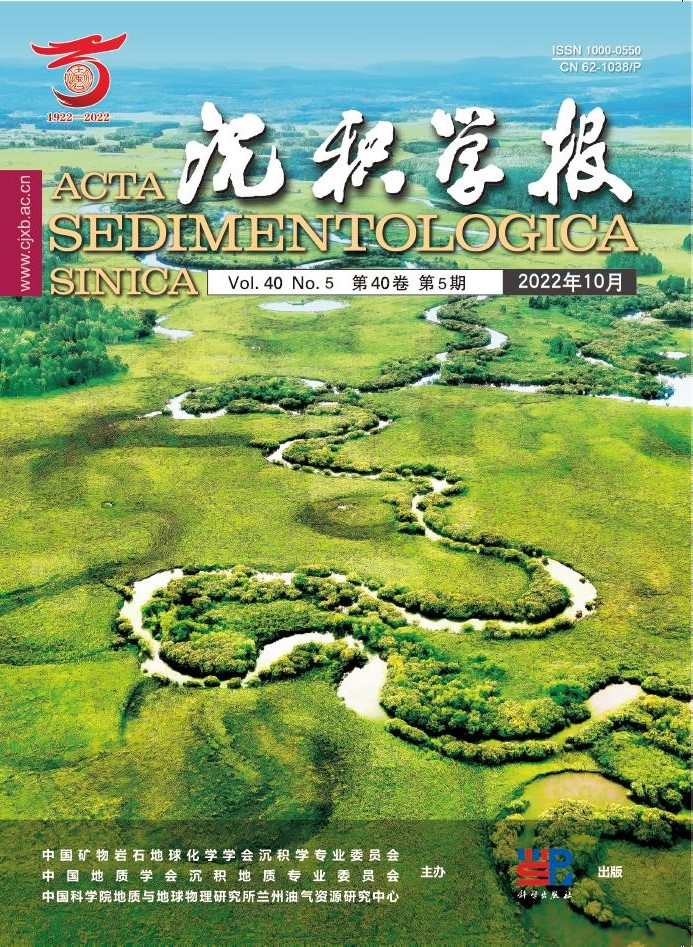HTML
-
页岩气主要以吸附态和游离态赋存于页岩微纳米孔隙—裂隙系统中,是一种典型的自生自储型非常规天然气[1-2]。与常规碎屑岩储层相比,页岩储层非均质性较强,孔喉系统窄小、连通关系复杂[3-4]。在页岩气生产开发过程中,甲烷分子通常需要沿着连通的孔隙网络运移至人工改造裂缝中才能被有效采出[5]。因此,准确评价页岩储层孔隙连通性对于水平井的布置和页岩气勘探开发潜力评价具有重要现实意义。
目前,孔隙连通性分析技术主要有高压压汞(MICP)、流体—示踪剂运移、纳米CT扫描(Nano-CT)和聚焦离子束扫描电镜(FIB-SEM)等[6-8]。高压压汞根据页岩样品在不同压力条件下的进汞和退汞特征可以估算页岩孔隙曲折度,侧面反映页岩基质孔隙连通程度[9]。流体自吸实验是润湿相在毛细管压力作用下自发地驱替非润湿相的过程,自吸曲线斜率可用于评价孔隙连通性特征。一般而言,当页岩样品的自吸斜率大于0.5时,页岩孔隙连通性较好;反之,当自吸斜率小于0.5时,则认为页岩孔隙连通性较差[7]。纳米CT通过X射线对页岩样品进行三维扫描,在三维建模和骨架模型的基础上可有效揭示页岩孔隙系统在空间中的连通程度[6,10]。本文在前人研究基础上,以焦石坝区块为例,对比分析不同构造单元页岩样品氦气孔隙度和核磁孔隙度差异,试图建立一种准确、快速且有效评价页岩储层孔隙连通性的方法,为页岩储层研究提供理论依据。
-
焦石坝区块整体位于四川盆地东南部(图1a),属于川东高陡褶皱带内一个特殊的“洼中隆”正向构造,面积约为347 km2[11]。构造上,焦石坝区块整体呈北东向展布,东西两翼受北东向(大耳山西断层和石门断层)和近南北向(乌江断层)两组逆断层夹持围限,北侧与天台场断层相接。燕山早、中期是研究区构造强烈变形期,区域内发生基底叠瓦冲断、盖层滑脱、左行压扭3个构造变形幕[2,12]。焦石坝断背斜核部变形程度整体较弱,背斜形态完整,顶部宽缓、地层倾角小(通常介于5°~10°),断层发育程度较低,翼部陡倾(可达30°以上)、断层较为发育(图1b,c)。

Figure 1. (a) Location map of the Jiaoshiba area in Sichuan Basin, modified from reference[2]; (b) map of well locations and structure outline in Jiaoshiba area; (c) geological cross⁃section between wells in study area
焦石坝地区奥陶系五峰组—志留系龙马溪组一段整体处于深水陆棚相沉积环境,岩性单一、细粒,以灰黑色含碳质放射虫笔石页岩为主[11,13]。根据钻井资料显示,五峰组—龙马溪组页岩横向分布稳定,厚度分布范围为80~120 m。研究区页岩干酪根类型主要为Ⅰ型,Ro为2.42%~2.80%(平均2.59%),处于热裂解生干气阶段[2,14]。综合页岩矿物组成和岩性特征,五峰组—龙马溪组一段页岩可进一步划分为9个小层,其中①~⑤小层有机碳含量较高,介于2%~5%(平均3.5%),脆性矿物(石英、长石、黄铁矿等)含量介于37.2%~83.4%(平均59.1%),具有较好的含气性和可压裂性,是目前页岩气探勘开发的主力层段[14-15]。
-
在测量页岩样品的氦气孔隙度之前,首先从新鲜的岩心样品上钻取直径约为2.5 cm、高度约为2.5 cm的柱状岩心样品。紧接着,将制备好的柱状岩心样品放入温度为110 ℃的干燥箱中干燥24 h[16]。待页岩样品充分干燥后,取出样品并放入KX-90F型覆压孔隙度测量仪,选用纯度为99.99%的氦气作为工作介质进行氦气孔隙度测量,测试原理为波义耳气体膨胀定律[17]。
氦气孔隙度测量完成后,将柱状岩心样品取出并重新放置于干燥箱充分干燥。与此同时,使用核磁共振仪测量孔隙度已知的标准岩样,获取孔隙度与核磁共振单位体积信号之间的定量关系[18]。紧接着,将干燥后的页岩样品放入浓度为30 g/L的KCl溶液,在35 MPa的条件下对岩心样品进行加压饱和盐水处理,时间约为24 h。待样品达到充分饱和状态且重量不再发生变化时,将饱和盐水后的柱状岩心样品取出并置于核磁共振仪内部,获取岩心样品的核磁共振信号值,进而计算出页岩样品的核磁孔隙度[18]。核磁共振实验测量过程中使用相对较低的磁场强度,约为0.3 T,共振频率为12.8 MHz,可识别孔径约为0.4 nm的孔隙。此外,主要的实验参数还包括等待时间为5 000 ms,扫描次数为128次,回波个数为2 048个,测试温度为32 ℃。
纳米CT通过X射线扫描页岩样品,三维重建后可得到高分辨率和高衬度的无损3D图像,单个像素点分辨率约为65 nm。本次纳米CT扫描实验是在中国石油勘探开发研究院(北京)完成,扫描电压为8 kV,实验温度为20 ℃,单幅曝光时间为90 s。CT扫描工作流程主要包括:1)沿垂直层理方向在新鲜岩心样品上钻取直径为1 mm、长度为0.5 cm的圆柱状岩样;2)使用牛津激光制样系统(型号为A-532-DW)将岩样顶端制成直径约65 µm、高约300 µm的微型圆柱体;3)旋转样品夹持器,连续记录样品从-90°旋转到90°这个过程中的X射线信息。扫描结束后,可获取一个以2D截面图片沿Z轴方向顺次叠加的圆柱形三维数据体,共计901张图像[10]。
-
图3显示,JYA井五峰组—龙马溪组页岩样品氦气孔隙度较高,分布范围为2.78%~5.73%,平均为3.90%,孔隙度大于3%的页岩样品占比高达90%,表明JYA井页岩具有良好的储集空间。JYB井页岩样品氦气孔隙度相对较低,整体介于1.1%~2.5%,均值为1.60%,孔隙度小于2%的页岩样品占比约为80%,表明JYB井页岩储集空间较为局限(图3)。图4展示了焦石坝地区两口研究井页岩样品的核磁孔隙度特征。总的来说,各页岩样品的核磁孔隙度明显大于氦气孔隙度,但整体特征与氦气孔隙度相似,即JYA井的核磁孔隙度明显大于JYB井(图4)。其中JYA井核磁孔隙度介于3.78%~6.25%,均值为4.56%;而JYB井核磁孔隙度分布范围为2.14%~3.32%,平均为2.78%(图4)。基于孔隙度测试结果,建立了所有页岩样品核磁孔隙度与氦气孔隙度关系图(图5)。图5显示,核磁孔隙度与氦气孔隙度线性关系在不同研究井中具有显著差异,不同实验方法表征的孔隙度在JYA井中展现出强烈的正相关关系,拟合度R2>0.8,而在JYB井中则无明显耦合关系。
-
前人研究表明,用柱样测量氦气孔隙度时,微小的氦气分子在充注压力作用下可以自由进入页岩储层中连通的微纳米孔隙[17]。换句话说,采用柱样测定的氦气孔隙度是页岩样品的有效(连通)孔隙度。核磁共振技术将饱和KCl溶液的柱状页岩样品置于均匀的静磁场中,基于样品中研究介质(如水)的氢原子核在磁场中的响应特征,不仅可以识别页岩储层中的连通孔隙,还可以表征常规实验方法无法测量的纳米级黏土束缚水孔隙(即所谓的闭孔),这也是核磁共振孔隙度普遍大于氦气孔隙度的主要原因[16,18-19]。因此,根据柱样测量的氦气孔隙度与核磁孔隙度之间的比值可以代表页岩样品中孔隙连通性特征。
分析结果显示,焦石坝地区不同构造单元页岩样品孔隙连通性差异较大(图6)。其中,位于构造稳定区JYA井的页岩孔隙连通性较好,连通孔隙占比介于69.13%~94.94%,平均值为85.12%。较高含量的连通孔隙比例使得氦气孔隙度所表征的连通孔隙基本能反映页岩样品的真实孔隙度,因此氦气孔隙度与核磁孔隙度之间正相关关系明显(图5)。另一方面,位于焦石坝断背斜翼部的JYB井页岩孔隙连通性较差,连通孔隙占比分布范围为36.15%~81.71%,平均值为58.19%(图6)。较低的连通孔隙比例导致氦气法无法有效表征页岩孔隙结构特征,因此氦气孔隙度与核磁孔隙度无明显线性关系(图5)。页岩渗透率作为反映储层孔隙结构特征的重要指标之一,通常与孔隙连通性成正相关关系。从页岩样品的脉冲渗透率结果(非裂缝点渗透率测量结果)可以看出,JYA井页岩渗透率较高,整体介于(0.003 4~0.025)×10-3 μm2,均值为0.010 9×10-3 μm2,JYB井页岩渗透率较低,分布范围为(0.001 2~0.008 2)×10-3 μm2,均值为0.004 3×10-3 μm2(图6),从而验证了根据核磁孔隙度和氦气孔隙度差异评价页岩孔隙连通性结果的有效性。
为了进一步评价该方法的适用性及结果的可靠性,本次研究对两口关键井同一小层的两块页岩样品(JYA-10和JYB-10)进行纳米CT扫描实验。由于不同物质组分对X射线具有不同的吸收效率,从而展现出不同的灰度差异。其中,组分密度越高,则灰度值越高(即越亮),如黄铁矿。反之,组分密度越低,相应的灰度值也越低(即越暗);如有机质,而孔隙则表现为深黑色[10]。为了保证三维重构的感兴趣区域具有代表性以及降低样品边缘效应带来的误差,本次研究在原始圆柱形三维数据体中心区域提取最大内切立方体进行重构分析。孔隙、有机质、基质矿物(石英、长石和黏土等)以及高密度矿物分别用红色、蓝色、灰色和黄色表示(图7a,d)。与此同时,将数据体中的孔隙单独提取(图7b,e),并在此基础上根据Avizo 9.0软件中的骨架模型自动模拟页岩孔隙之间的连通性特征(图7c,f)。图7显示,JYA井页岩孔隙在三维空间中主要呈聚集的团块状和饱满的椭球状,大部分相对孤立的孔隙首先与小喉道(橘红色)连接,进一步汇聚于多个中喉道(橙黄色)或大喉道(亮白色)之上,形成连通性较好且连通范围较广的孔喉网络系统。仅少量孔隙通过单一的小喉道连接,较其他孔喉系统相对孤立。总的来说,JYA井页岩孔隙在空间上连通性较好,与通过氦气孔隙度和核磁孔隙度识别的高连通孔隙率(连通孔隙率约为91.68%)具有一致性(图6)。相反,JYB井页岩孔隙在三维空间上呈离散分离状,孔隙也相对扁平,且大部分孔隙仅通过相邻孔间单一的小喉道连接,连接的孔喉系统规模较小,表明JYB井页岩孔隙连通性较差,与孔隙度评价结果(连通孔隙率约为39.84%)相符(图6)。
-
与常规油气藏开发方式相比,页岩气的商业生产主要依赖于水平井和水力压裂改造技术[4,21]。在压裂过程中,大量压裂液泵入页岩储层,并快速渗吸到页岩内部,促进页岩气储层吸水产生微裂缝,改善页岩储层改造效果。然而,已有的研究指出,页岩气井压裂后返排难度大,返排率通常只有5%~40%,滞留的压裂液通过水相圈闭或储层结垢(如Ca2+、Mg2+生成碳酸盐和硫酸盐沉淀)等作用导致页岩孔隙和裂缝堵塞,不利于页岩气的产出[22-24]。分析结果显示,焦石坝地区JYA井五峰组—龙马溪组主力层段页岩孔隙连通性较好,连通孔隙占比介于69.13%~94.94%(平均85.12%),大量发育的孔隙网络极大地改善了页岩储层渗透率(图6,7),进而增强了页岩储层的自吸能力[7]。此外,压裂液可通过连通范围较广的孔隙网络进入页岩储层深部(图7),扩大压裂改造范围,有效地提高页岩气产量。更重要的是,在页岩储层压裂改造完成后,压裂液亦可通过连通的孔隙网络反排回收,基本不会引起水锁伤害[21,24]。JYB井五峰组—龙马溪组页岩孔隙连通性较差,连通孔隙占比为36.15%~81.71%(平均58.19%),渗透率均值仅为0.004 3×10-3 μm2,页岩储层自吸能力相对较弱,且局限的孔隙网络导致压裂液扩散距离较短(图6,7),压裂改造范围和效果较差,不利于页岩气的高产[7,22-23]。
-
(1) 采用柱样岩心测定的氦气孔隙度主要为页岩样品的连通孔隙度,而核磁共振实验可实现连通孔和闭孔的综合识别。因此,基于两种实验方法表征的孔隙度差异,可量化页岩储层孔隙连通性特征。
(2) 稳定区JYA井页岩样品氦气孔隙度为2.78%~5.73%(平均3.90%),核磁孔隙度为3.78%~6.25%(平均4.56%),计算出连通孔隙占比为69.13%~94.94%(平均85.12%)。较高含量的连通孔隙比例使得氦气孔隙度所表征的连通孔隙基本能反映页岩样品的真实孔隙度,因此氦气孔隙度与核磁孔隙度之间呈明显的正相关关系。
(3) 变形区JYB井页岩氦气孔隙度为1.1%~2.5%(平均1.60%),核磁孔隙度为2.14%~3.32%(平均2.78%),对应的连通孔隙占比为36.15%~81.71%(平均58.19%),孔隙之间连通性较差。较低的连通孔隙比例导致氦气孔隙度无法有效反映页岩孔隙结构特征,因此氦气孔隙度与核磁孔隙度无明显线性关系。
(4) 页岩储层中连通性较好的孔隙网络不仅有利于压裂液自吸、扩散,扩大水力压裂改造范围,还有利于压裂改造完成后压裂液的反排回收,防止水相圈闭或储层结垢等作用,从而有效地提高页岩气产量。













 DownLoad:
DownLoad:





